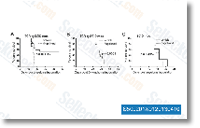The substantial body of proof presented in this work points towards the accomplishment of switch like gene sets in cap turing biologically pertinent gene expression signatures from microarray data. Given the demonstrated biological relevance of bimodal expression patterns, it might be worthwhile to find out the clinical relevance of switch like gene annotation. Iden tification of bimodal genes expressed inside the activated state in complicated illnesses this kind of as autism, diabetes and cancer may perhaps supply a strategy for dimension reduction within the identification of sickness linked single nucleotide poly morphisms and expression quantitative trait loci in genome broad association scientific studies. The two gene sequences and promoter areas of bimodal genes expressed inside the large mode identified from substantial scale microarray data may very well be searched for SNPs and eQTL linked to your onset of sickness or disorder progression.
Further scientific studies are required to investigate the full probable of clinically pertinent classification using switch like gene annotation from microarray information. Conclusion In selleck RAF265 this review, we showed that a priori knowledge gained from compilation of significant scale microarray datasets from various laboratories containing at the least 400 samples for each gene during the array might be effectively utilized in reduc ing the dimension of functions in microarray examination. We lowered dimensionality by concentrating on a set of genes with bimodal expression patterns, i. e. genes that adopt either an on or off mode of expression and therefore are tightly regu lated with the transcript degree. Detection syk inhibitor of bimodality using expectation maximization revealed a checklist of 1265 bimodal genes during the human genome.
A subset of 300 bimodal genes was adequate to differentiate among nineteen dif ferent tissue signatures even in tiny sample sizes. These genes code for proteins both to the cell membrane or with the extracellular  matrix. Such proteins could be recognized in tissue working with fluorescence, Q dots together with other techniques and as this kind of are candidate biomarkers for unique tissues. The set of bimodal genes are capable of capturing infec tious illness signatures from microarray information correspond ing to hepatitis C, influenza, HIV one infection and malaria. Condition unique expression patterns of bimodal genes sug gest that infection by different pathogens may initiate dif ferent host responses mediated by switch like gene expression. Determination of on and off states of switch like genes in various tissues and illnesses permitted for that identification of activated deactivated pathways which have been constant with present exploration data. Classifica tion accuracy was exceptional even with class particular sample sizes between 10 and twenty arrays.
matrix. Such proteins could be recognized in tissue working with fluorescence, Q dots together with other techniques and as this kind of are candidate biomarkers for unique tissues. The set of bimodal genes are capable of capturing infec tious illness signatures from microarray information correspond ing to hepatitis C, influenza, HIV one infection and malaria. Condition unique expression patterns of bimodal genes sug gest that infection by different pathogens may initiate dif ferent host responses mediated by switch like gene expression. Determination of on and off states of switch like genes in various tissues and illnesses permitted for that identification of activated deactivated pathways which have been constant with present exploration data. Classifica tion accuracy was exceptional even with class particular sample sizes between 10 and twenty arrays.
BRAF signal
The BRAF gene is a proto-oncogene
